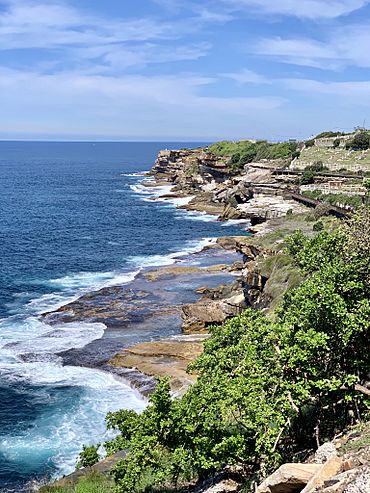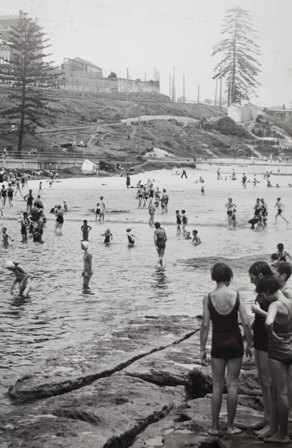Clovelly, New South Wales facts for kids
Quick facts for kids ClovellySydney, New South Wales |
|||||||||||||||
|---|---|---|---|---|---|---|---|---|---|---|---|---|---|---|---|

Eastern Beaches Coastal Walk, Covelly, New South Wales
|
|||||||||||||||
| Population | 4,736 (2016 census) | ||||||||||||||
| Postcode(s) | 2031 | ||||||||||||||
| Location | 8 km (5 mi) south-east of Sydney CBD | ||||||||||||||
| LGA(s) | City of Randwick | ||||||||||||||
| State electorate(s) | Coogee | ||||||||||||||
| Federal Division(s) | Wentworth | ||||||||||||||
|
|||||||||||||||
Clovelly is a small beachside suburb in Sydney's Eastern Suburbs, in the state of New South Wales, Australia. It is about 8 kilometers (5 miles) south-east of the Sydney city center.
Clovelly is mostly a residential area built around Clovelly Bay. Clovelly Beach is a small beach at the end of this narrow bay. The bay is a very popular spot for swimmers. It is also home to one of the first surf lifesaving clubs in the world, the Clovelly Surf Life Saving Club, which started in 1906.
Contents
What is the History of Clovelly?
Clovelly was first called Little Coogee. But in 1913, its name was changed to Clovelly. When people were looking for a new name, someone suggested Eastbourne, an English seaside town. However, Mr. F. H. Howe, who led the local community group, suggested Clovelly. This name came from a local property owned by Sir John Robertson, which was named after a village called Clovelly on the north Devon coast in England.
In 1834, William C. Greville bought a large piece of land, about 20 acres (8 hectares), for 40 pounds. This land included the entire bay area. For most of the 1800s, the area was known for a grand estate called Mundarrah Towers.
Mundarrah Towers was built for Dr. Dickson in the 1860s. Later, Samuel Bennett, who owned a very important newspaper called Australian Town and Country Journal, bought the property and made it even grander. The Towers building was taken down in 1926 to make space for new homes. The Mundarrah Towers estate was located around Burnie Street, looking over the western part of Clovelly Bay. Today, Mundarrah Street is named after this important part of Clovelly's past.
Between Coogee and Clovelly, on the shores of Gordon's Bay, was another large home called Cliffbrook. This house was built for John Thompson. By the early 1900s, the first leader of the Commonwealth Bank lived in this grand mansion. Most of it was taken down in 1976. However, some parts of the Cliffbrook estate still stand today at the corner of Beach and Battery streets.
Between 1871 and 1874, the northern cliff of Clovelly Beach, known as Shark Point, was used for coastal defense. Soldiers dug out barracks (places for soldiers to live) and a powder magazine (where gunpowder was stored) from the sandstone. By 1893, a large 9.2-inch British Armstrong "disappearing" gun was placed there. The underground barracks and gun area were gradually taken down in the 1960s.
Today, many people who live in Clovelly or nearby lovingly call the suburb "Cloey."
How Did Trams Help Clovelly Grow?
The Clovelly tram line started in 1912, connecting Alison Road to Clovelly and Carrington Roads. In 1913, it was extended all the way to Clovelly Beach. This tram line helped make the area much more popular.
The tram line branched off from Anzac Parade at Alison Road. It ran next to Centennial Park on its own special track. At Darley Road, it separated from the trams going to Coogee. It then turned right onto Clovelly Road and went down to its final stop at Clovelly Beach. Even though trams ran from places like Circular Quay, the line closed in 1957. Today, the Transdev John Holland bus route 339 follows the old tram line's path.
Where Can You Shop in Clovelly?
Clovelly has four small shopping areas, all located on or near Clovelly Road.
- The biggest shopping area is at the corner of Fern Street and Clovelly Road. Here you can find a post office, a community bank, a chemist (pharmacy), a newsagent, and a bottle shop.
- At the corner of Arden Street and Clovelly Road, there's another small area with coffee shops, places to eat, a general store, and another bottle shop.
- A few more shops are located at the corner of Carrington and Clovelly Road.
- Close to Clovelly Beach, there's a small group of shops where Burnie Street meets Clovelly Road.
Clovelly also has one hotel by the beach, called the Clovelly Hotel. It was built on some of the land where the old Mundarrah Towers estate used to be. There is also the Clovelly Bowling Club, which has great views of the coast and is next to the Waverley Cemetery.
What Schools are in Clovelly?
- Clovelly Public School (even though it's technically in the suburb of Waverley)
- St Anthony's Catholic Systemic Primary School, Clovelly
What Sports and Activities Can You Do in Clovelly?
In summer, Clovelly Beach is a busy place. Lifeguards from the council watch over the beach on weekdays, and members of the Clovelly Surf Life Saving Club patrol on weekends and public holidays. In 2006, the club had over 200 trained members helping to keep swimmers safe.
In winter, the Clovelly Crocodiles have more than 20 junior rugby league teams that play in the Sydney Roosters Juniors competition. Their home ground is Burrows Park. In 2006, the Clovelly Eagles had 18 junior rugby union teams playing in the Randwick/Easts Junior division.
The Clovelly Eskimos Winter Swimming Club competes against other clubs like the Bondi Icebergs and the Coogee Penguins in the Winter Swimming Association of Australia Championships.
You can also play lawn bowls and bocce at the Clovelly Bowling Club. It's located on top of a cliff and offers beautiful views.
Who Lives in Clovelly?
| Historical population | ||
|---|---|---|
| Year | Pop. | ±% |
| 2001 | 4,359 | — |
| 2006 | 4,426 | +1.5% |
| 2011 | 4,581 | +3.5% |
| 2016 | 4,736 | +3.4% |
According to the 2016 census, 4,736 people lived in Clovelly.
- About 67.3% of the people were born in Australia.
- The next most common countries of birth were England (8.2%) and New Zealand (2.5%).
- Most people (83.2%) spoke only English at home.
- For religion, the most common answers were No Religion (38.5%), Catholic (25.3%), and Anglican (12.7%).
- Clovelly has more apartments, flats, semi-detached houses, terrace houses, or townhouses (73.4%) compared to the average across Australia (25.8%).
Who are Some Famous People from Clovelly?
- Clare Dennis (1916–1971), a gold medalist in swimming at the 1932 Summer Olympics
- Don Furness, a rugby union player
- David Gallop, a former CEO of the National Rugby League
- Sel Lisle, a rugby league player
- Willie Mason, a rugby league player
- Dane Rampe, an Australian rules football player
- Luke Ricketson, a rugby league player
- Peter Ruehl (1947–2011), an American newspaper writer
- Justine Schofield, a cook and TV presenter
- David Walker, a Catholic bishop




